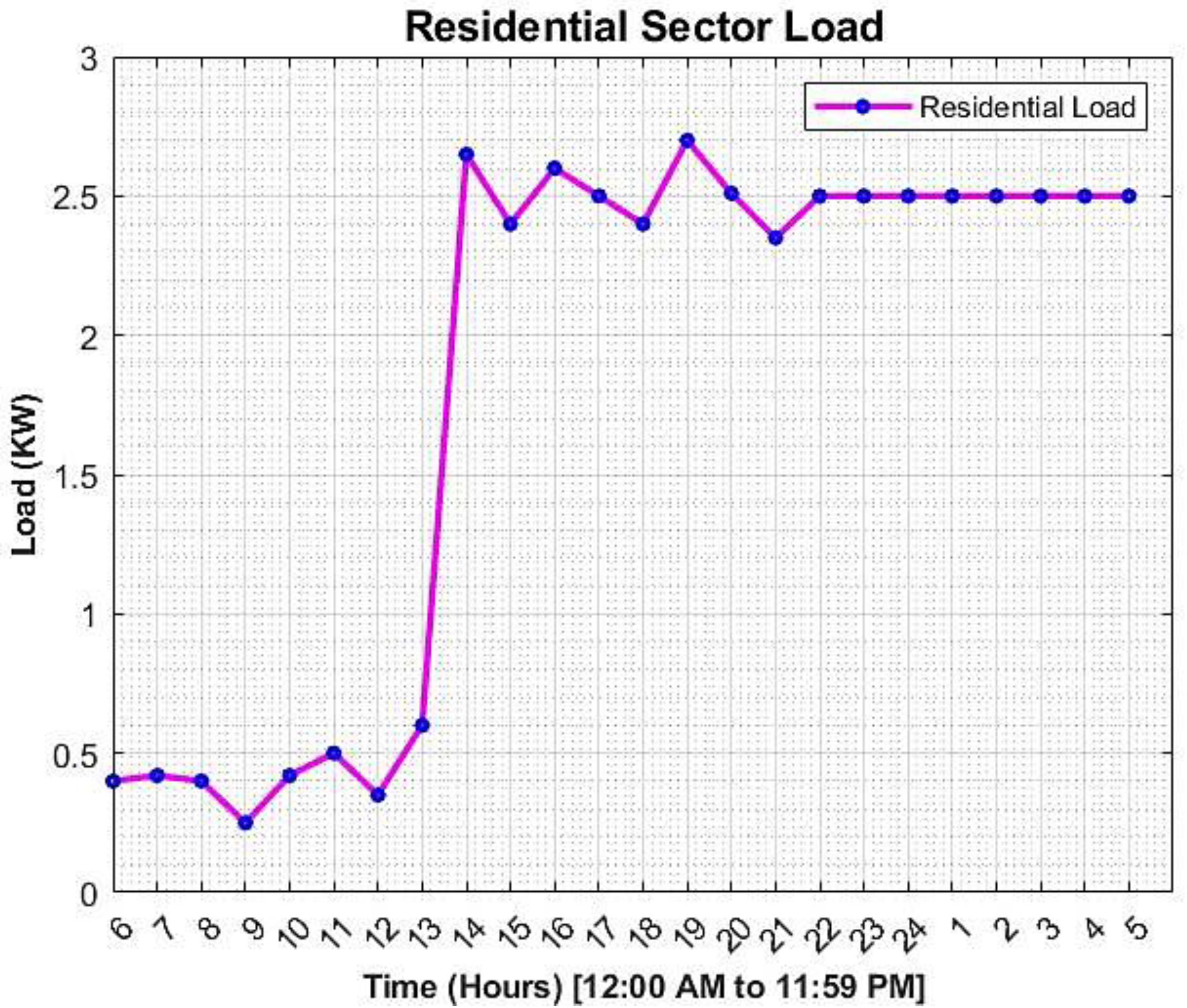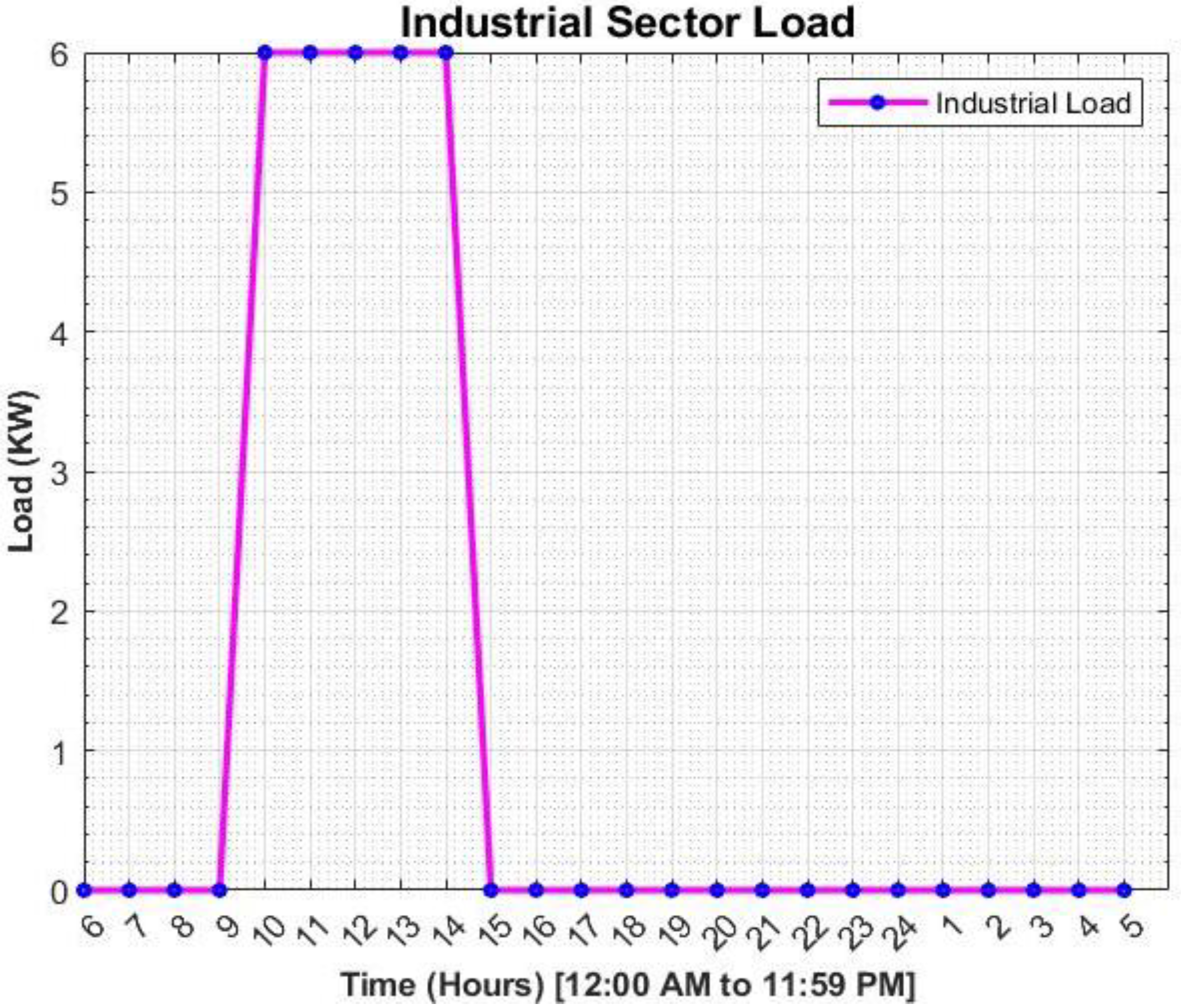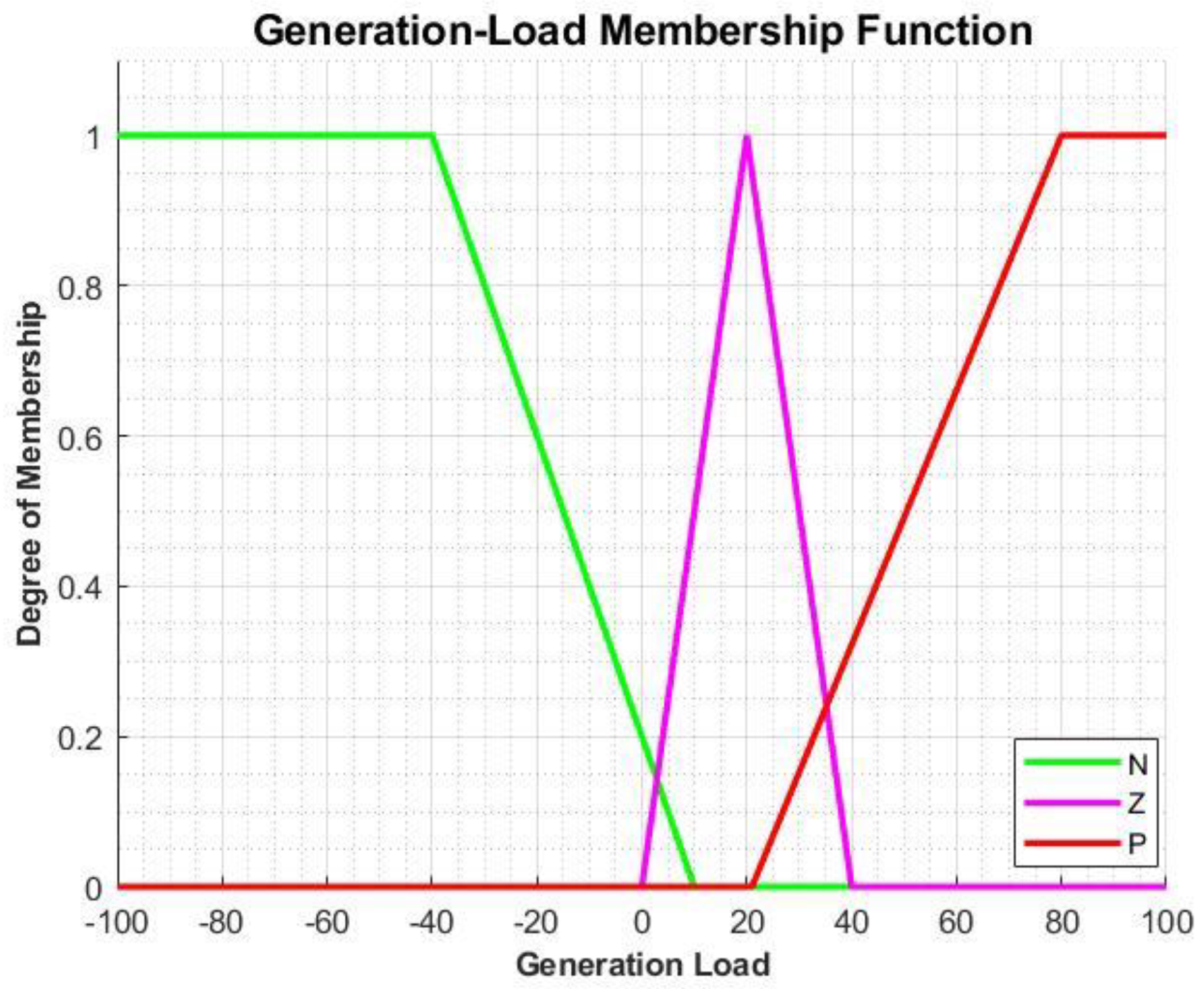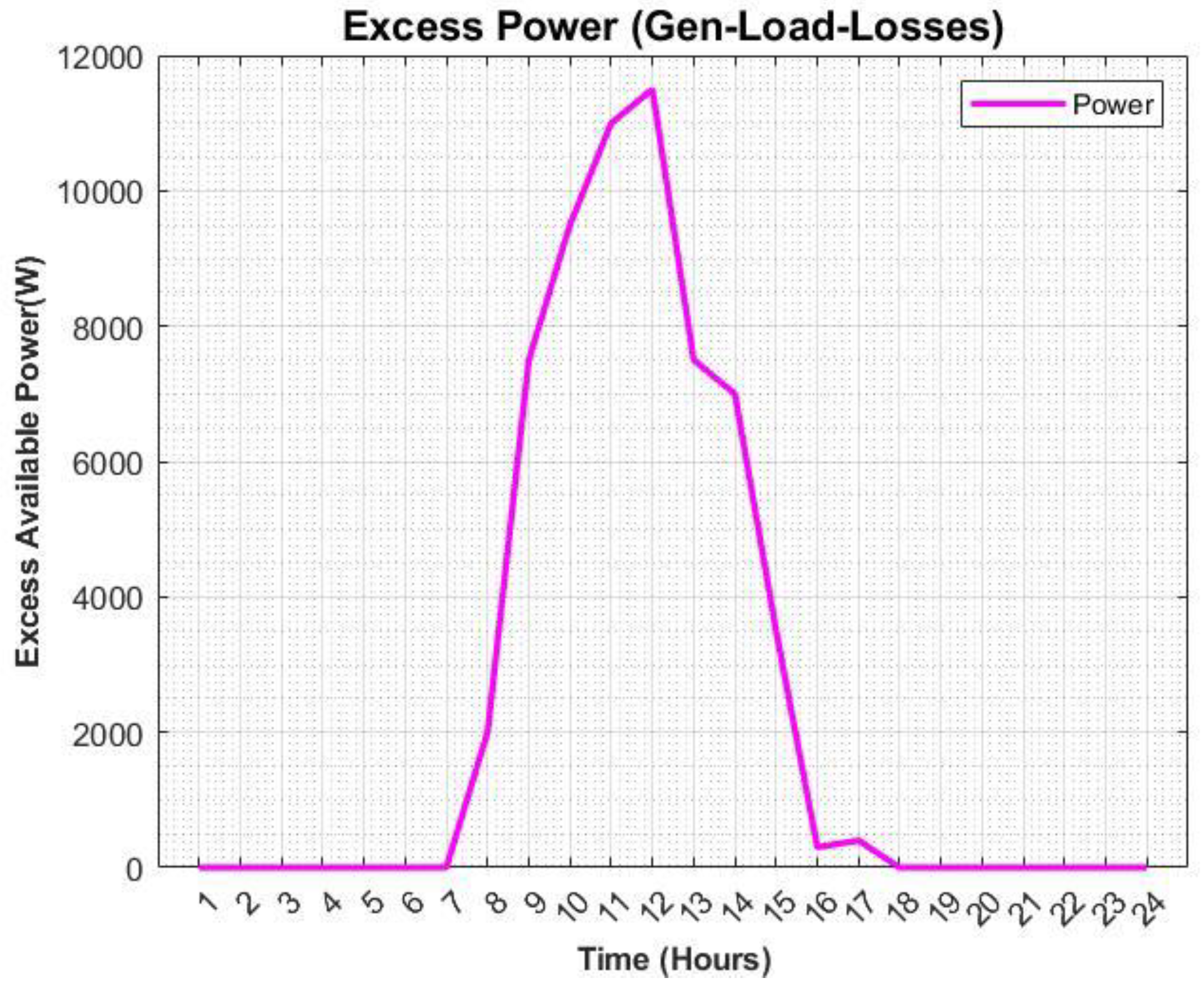Load Management and Optimal Sizing of Special-Purpose Microgrids Using Two Stage PSO-Fuzzy Based Hybrid Approach
Abstract
:1. Background
2. Introduction
2.1. Energy Management Systems
2.2. Storage Sizing Schemes
3. Problem Statement
Algorithm Novelty and Contribution
- In this research, a hybrid approach to sizing the microgrid is developed. The hybrid approach covers the reliability factor in microgrid operation using the control scheme instead of enhancing the battery sizing, days of autonomy and other reliability factors such as enhancing solar PV power and main grid support.
- An integrated hybrid fixed and operational mode-based algorithm design to tackle the unscheduled heavy load operation in islanded microgrids with intermittent renewable energy resources.
- Design of optimal sizing algorithm using Particle Swarm Optimization to reduce the overall system sizing cost.
- Design of Intelligent scheduling of uncertain loads using fuzzy logic to ensure real-time reliability avoiding the small peaks during low power availability.
- Integration, validation, and testing of the PSO sizing algorithm with Fuzzy Intelligent Scheduling.
- Economic analysis of the proposed system compared with the actual installed system.
4. Methodology
4.1. Analysis of Existing Open System Design
4.2. Proposed System
4.3. Fixed Mode: Optimal System Sizing
4.3.1. Problem Formulation
4.3.2. Objective Function
4.3.3. Battery Sizing
4.3.4. Constraints
4.3.5. Designed Algorithm for Full Load Operation
4.3.6. Fuzzy Logic System the Load Flexibility Zones
5. Discussion and Results
5.1. Optimal Sizing Values from PSO
5.2. Fuzzy Simulation Results
- Operation of the CPP during excess power availability;
- Operation of the DS during the night and daytime;
- Charging of the battery storage during the daytime;
- Restriction or turning off the CPP as per the availability of the solar PV.
6. Conclusions and Future Work
Author Contributions
Funding
Institutional Review Board Statement
Informed Consent Statement
Data Availability Statement
Conflicts of Interest
References
- Robert, F.C.; Sisodia, G.S.; Gopalan, S. The critical role of anchor customers in rural microgrids: Impact of load factor on energy cost. In Proceedings of the 2017 International Conference on Computation of Power, Energy Information and Commuincation (ICCPEIC), Melmaruvathur, India, 22–23 March 2017; pp. 398–403. [Google Scholar]
- Rana, M.M.; Atef, M.; Sarkar, M.R.; Uddin, M.; Shafiullah, G.M. A Review on Peak Load Shaving in Microgrid—Potential Benefits, Challenges, and Future Trend. Energies 2022, 15, 2278. [Google Scholar] [CrossRef]
- Kashem, S.B.; De Souza, S.; Iqbal, A.; Ahmed, J. Microgrid in military applications. In Proceedings of the 2018 IEEE 12th International Conference on Compatibility, Power Electronics and Power Engineering (CPE-POWERENG 2018), Doha, Qatar, 10–12 April 2018; pp. 1–5. [Google Scholar]
- Li, H.; Eseye, A.T.; Zhang, J.; Zheng, D. Optimal energy management for industrial microgrids with high-penetration renewables. Prot. Control. Mod. Power Syst. 2017, 2, 1–4. [Google Scholar] [CrossRef]
- Ghasemi, A. Coordination of pumped-storage unit and irrigation system with intermittent wind generation for intelligent energy management of an agricultural microgrid. Energy 2018, 142, 1–3. [Google Scholar] [CrossRef]
- Pasha, A.M.; Ibrahim, H.M.; Hasan, S.R.; Belkacemi, R.; Awwad, F.; Hasan, O. A Utility maximized demand-side management for autonomous microgrid. In Proceedings of the 2018 IEEE Electrical Power and Energy Conference (EPEC), Toronto, ON, Canada, 10–11 October 2018; pp. 1–5. [Google Scholar]
- De Souza, A.Z.; da Silva Neto, J.A.; de Carvalho Costa, J.G.; Portelinha, F.M.; Marujo, D. An offline fuzzy-based decision-Making to load shedding in microgrids. In Proceedings of the 2019 IEEE PES Innovative Smart Grid Technologies Conference-Latin America (ISGT Latin America), Gramado, Brazil, 15–18 September 2019; pp. 1–6. [Google Scholar]
- Keller, E.; Patton, F. Microgrid load management and operation. In Proceedings of the 2016 IEEE Rural Electric Power Conference (REPC), Westminster, CA, USA, 5 May 2016; pp. 27–30. [Google Scholar]
- Oliveira, D.Q.; de Souza, A.Z.; Santos, M.V.; Almeida, A.B.; Lopes, B.I.L.; Saavedra, O.R. A fuzzy-based approach for microgrids islanded operation. Electr. Power Syst. Res. 2017, 149, 178–189. [Google Scholar] [CrossRef]
- Mahmud, M.P.; Hossain, M.J.; Nizami, M.S.H.; Rahman, M.S.; Farjana, S.H.; Huda, N.; Lang, C. Advanced power routing framework for optimal economic operation and control of solar photovoltaic-based islanded microgrid. IET Smart Grid 2019, 2, 242–249. [Google Scholar] [CrossRef]
- Loukakis, E.; Karapidakis, E. Feasibility study of microgrid village with renewable energy sources. In Proceedings of the 2017 52nd International Universities Power Engineering Conference (UPEC), Heraklion, Greece, 28–31 August 2017; pp. 1–6. [Google Scholar]
- Gunasekaran, M.; Mohamed Ismail, H.; Chokkalingam, B.; Mihet-Popa, L.; Padmanaban, S. Energy management strategy for rural communities’ DC micro grid power system structure with maximum penetration of renewable energy sources. Appl. Sci. 2018, 8, 585. [Google Scholar] [CrossRef]
- Mi, Y.; Chen, X.; Ji, H.; Ji, L.; Fu, Y.; Wang, C.; Wang, J. The coordinated control strategy for isolated DC microgrid based on adaptive storage adjustment without communication. Appl. Energy 2019, 252, 113465. [Google Scholar] [CrossRef]
- Singh, K. Power Management and Power Quality Improvement of Isolated Hybrid Microgrid for Village Electrification. 2019. Available online: http://hdl.handle.net/10603/256701 (accessed on 1 June 2022).
- Abdel-hamed, A.M.; Ellissy, K.; Adly, A.R.; Abdelfattah, H. Optimal Sizing and Design of Isolated Micro-Grid systems. Int. J. Environ. Sci. Sustain. Dev. 2019, 4, 1–19. [Google Scholar] [CrossRef]
- Pascual, J.; Barricarte, J.; Sanchis, P.; Marroyo, L. Energy management strategy for a renewable-based residential microgrid with generation and demand forecasting. Appl. Energy 2015, 158, 12–25. [Google Scholar] [CrossRef]
- Huang, R.; Huang, T.; Gadh, R.; Li, N. Solar generation prediction using the ARMA model in a laboratory-level micro-grid. In Proceedings of the 2012 IEEE Third International Conference on Smart Grid Communications (Smart Grid Comm), Tainan, Taiwan, 5–8 November 2012; pp. 528–533. [Google Scholar]
- Khodaei, A.; Bahramirad, S.; Shahidehpour, M. Microgrid planning under uncertainty. IEEE Trans. Power Syst. 2014, 30, 2417–2425. [Google Scholar] [CrossRef]
- Hernandez, L.; Baladron, C.; Aguiar, J.M.; Carro, B.; Sanchez-Esguevillas, A.J.; Lloret, J.; Massana, J. A survey on electric power demand forecasting: Future trends in smart grids, microgrids and smart buildings. IEEE Commun. Surv. Tutor. 2014, 16, 1460–1495. [Google Scholar] [CrossRef]
- Aftab, M.A.; Hussain, S.S.; Ali, I.; Ustun, T.S. IEC 61850 and XMPP communication based energy management in microgrids considering electric vehicles. IEEE Access 2018, 6, 35657–35668. [Google Scholar] [CrossRef]
- Bani-Ahmed, A.; Weber, L.; Nasiri, A.; Hosseini, H. Microgrid communications: State of the art and future trends. In Proceedings of the 2014 International Conference on Renewable Energy Research and Application (ICRERA), Milwaukee, WI, USA, 19–22 October 2014; pp. 780–785. [Google Scholar]
- Zhang, B.; Baillieul, J. Control and communication protocols based on packetized direct load control in smart building microgrids. Proc. IEEE 2016, 104, 837–857. [Google Scholar] [CrossRef]
- Wei, C.; Li, X.; Maleki, A.; Pourfayaz, F.; Rosen, M.A.; Nazari, M.A.; Bui, D.T. Optimal sizing and location based on economic parameters for an off-grid application of a hybrid system with photovoltaic, battery and diesel technology. Energy 2020, 201, 117480. [Google Scholar] [CrossRef]
- Akbar, M.; Nazari, M.A.; Pourfayaz, F. Harmony search optimization for optimum sizing of hybrid solar schemes based on battery storage unit. Energy Rep. 2020, 6, 102–111. [Google Scholar] [CrossRef]
- Jingchao, L.; Mei, L.; Maleki, A.; Ghasempour, R.; Pourfayaz, F. A Global Dynamic Harmony Search for Optimization of a Hybrid Photovoltaic-Battery Scheme: Impact of Type of Solar Panels. Sustainability 2021, 14, 109. [Google Scholar] [CrossRef]
- Tostado-Véliz, M.; Icaza-Alvarez, D.; Jurado, F. A novel methodology for optimal sizing photovoltaic-battery systems in smart homes considering grid outages and demand response. Renew. Energy 2021, 170, 884–896. [Google Scholar] [CrossRef]
- Wenqiang, Z.; Guo, J.; Zhao, G.; Zeng, B. Optimal Sizing of an Island Hybrid Microgrid Based on Improved Multi-Objective Grey Wolf Optimizer. Processes 2020, 8, 1581. [Google Scholar] [CrossRef]
- El-Bidairi, K.S.; Nguyen, H.D.; Mahmoud, T.S.; Jayasinghe, S.D.G.; Guerrero, J.M. Optimal sizing of Battery Energy Storage Systems for dynamic frequency control in an islanded microgrid: A case study of Flinders Island, Australia. Energy 2020, 195, 117059. [Google Scholar] [CrossRef]
- Bin, C.; Dong, W.; Lv, Z.; Gu, Y.; Singh, S.; Kumar, P. Hybrid microgrid many-objective sizing optimization with fuzzy decision. IEEE Trans. Fuzzy Syst. 2020, 28, 2702–2710. [Google Scholar] [CrossRef]
- Soumya, B.; Mouli, G.R.C.; Qin, Z.; Elizondo, L.R.; Bauer, P. Techno-economical model based optimal sizing of PV-battery systems for microgrids. IEEE Trans. Sustain. Energy 2019, 11, 1657–1668. [Google Scholar] [CrossRef]
- Li, J. Optimal sizing of grid-connected photovoltaic battery systems for residential houses in Australia. Renew. Energy 2019, 136, 1245–1254. [Google Scholar] [CrossRef]
- Ahmed, F.; Kaaniche, K.; Alanazi, T.M. Recent approach based social spider optimizer for optimal sizing of hybrid PV/wind/battery/diesel integrated microgrid in aljouf region. IEEE Access 2020, 8, 57630–57645. [Google Scholar] [CrossRef]
- Vanika, S.; Haque, M.H.; Aziz, S.M. Energy cost minimization for net zero energy homes through optimal sizing of battery storage system. Renew. Energy 2019, 141, 278–286. [Google Scholar] [CrossRef]
- Orlando, T.; Du, H. Optimal sizing and energy scheduling of photovoltaic-battery systems under different tariff structures. Renew. Energy 2018, 129, 513–526. [Google Scholar] [CrossRef]
- Shahbaz, H.; Alammari, R.; Iqbal, A.; Shikfa, A. Optimal sizing of a stand-alone hybrid PV-WT-BT system using artificial intelligence based technique. In Proceedings of the 2020 IEEE International Conference on Informatics, IoT, and Enabling Technologies (ICIoT), Doha, Qatar, 2–5 February 2020; pp. 55–60. [Google Scholar]
- Sanjay, K.; Kaur, T.; Upadhyay, S.; Sharma, V.; Vatsal, D. Optimal Sizing of Stand Alone Hybrid Renewable Energy System with Load Shifting. Energy Sources Part A Recovery Util. Environ. Eff. 2020, 1–20. [Google Scholar] [CrossRef]
- Mohammed, R.H.; Gomes, C.; Hazim, H.; Ahmadipour, M. Sizing and implementing off-grid stand-alone photovoltaic/battery systems based on multi-objective optimization and techno-economic (MADE) analysis. Energy 2020, 207, 118163. [Google Scholar] [CrossRef]
- Ibrahim, A.; Othmani, M.; Tatry, L. An Innovative and Holistic Approach for an Optimal Sizing of Mini-Grids in Rural Areas Integrating the Demand, the Supply, and the Network. 2020. Available online: https://papers.ssrn.com/sol3/papers.cfm?abstract_id=3593430 (accessed on 1 June 2022).
- Delnia, S.; Naghshbandy, A.H.; Bahramara, S. Optimal sizing of hybrid renewable energy systems in presence of electric vehicles using multi-objective particle swarm optimization. Energy 2020, 209, 118471. [Google Scholar] [CrossRef]
- Alberizzi, J.C.; Rossi, M.; Renzi, M. A MILP algorithm for the optimal sizing of an off-grid hybrid renewable energy system in South Tyrol. Energy Rep. 2020, 6, 21–26. [Google Scholar] [CrossRef]
- Di, W.; Ma, X.; Huang, S.; Fu, T.; Balducci, P. Stochastic optimal sizing of distributed energy resources for a cost-effective and resilient Microgrid. Energy 2020, 198, 117284. [Google Scholar] [CrossRef]
- Hamanah, W.M.; Abido, M.A.; Alhems, L.M. Optimum sizing of hybrid pv, wind, battery and diesel system using lightning search algorithm. Arab. J. Sci. Eng. 2020, 45, 1871–1883. [Google Scholar] [CrossRef]
- Makoto, S.; Gamil, M.M.; Akter, H.; Krishna, N.; Abdel-Akher, M.; Mandal, P.; Senjyu, T. Optimal sizing and operation for microgrid with renewable energy considering two types demand response. J. Renew. Sustain. Energy 2020, 12, 065901. [Google Scholar] [CrossRef]
- Zhehan, Y.; Dong, W.; Etemadi, A.H. A unified control and power management scheme for PV-battery-based hybrid microgrids for both grid-connected and islanded modes. IEEE Trans. Smart Grid 2017, 9, 5975–5985. [Google Scholar] [CrossRef]














| Ref. | Year | Optimization Approach | Methodology | Load Parameter | Reliability Factors |
|---|---|---|---|---|---|
| [32] | 2019 | SSO | An SSO has been proposed to determine the sizing of an integrated hybrid micro-grid by considering three design parameters, i.e., PV modules, wind turbines, and battery storage capacity to minimize the cost of energy. | Annual load of the city in Saudi Arabia has been taken in study. Battery cost optimization is performed while using load as a fixed known parameter. | Loss of power supply probability (LPSP) is considered during the event of less generation compared to the running load |
| [33] | 2019 | UMF | A UMF-based optimization technique is applied to the proposed model to select the optimal size of the battery and PV system to reduce the annual net payment (ANP). | The optimum size of a BESS for any typical NZE residential load with a rooftop solar PV system to reduce yearly net energy and battery costs | SOC level of battery taken into consideration as the reliability factor in this research. |
| [35] | 2020 | MDPSO | A multi-dimensional optimization approach has been used for optimal sizing of PV and wind with a battery storage system by reducing the objective functions of cost, dump power, and reliability. | Residential dump Load of a Stand-Alone PV-WT-BT hybrid system configuration is considered. | The planning horizon consists of the total P = H ∗ P′. Here H is the week, month, year. The P′ is the minutes, hours, and seconds. |
| [36] | 2020 | PSO and BBO | An optimal sizing problem has been addressed using PSO and BBO algorithm for a hybrid micro-gird based on a PV system with battery storage to reduce the cost and environmental effects for load shifting. | The Sizing optimization of batteries is performed with the help of HRES. |
| Parameter | Optimal Values |
|---|---|
| Number of Batteries | 2 |
| Current in Ah | 217 |
| Solar PV | 11,158 |
| Current in A | 52.2 |
| Sizing Based on PSO | Actual Sizing of the Microgrid Installed | ||||||||
|---|---|---|---|---|---|---|---|---|---|
| Parameter | Optimal Values | Number of Units | Cost per Unit | Optimal Cost | Parameter | Previous Values | Number of Units | Cost per Unit | Optimal Cost |
| Battery Capacity | 2024 | 02 | 30,000 | 60,000 | Battery Capacity | 64,000 | 24 | 30,000 | 720,000 |
| Solar PV Power | 11,158 | 37 | 30,000 | 592,000 | Solar PV Power | 20,000 | 66 | 30,000 | 1,980,000 |
| Total Cost | 652,000 | Total | 2,700,000 | ||||||
Publisher’s Note: MDPI stays neutral with regard to jurisdictional claims in published maps and institutional affiliations. |
© 2022 by the authors. Licensee MDPI, Basel, Switzerland. This article is an open access article distributed under the terms and conditions of the Creative Commons Attribution (CC BY) license (https://creativecommons.org/licenses/by/4.0/).
Share and Cite
Azeem, F.; Ahmad, A.; Gondal, T.M.; Arshad, J.; Rehman, A.U.; Eldin, E.M.T.; Shafiq, M.; Hamam, H. Load Management and Optimal Sizing of Special-Purpose Microgrids Using Two Stage PSO-Fuzzy Based Hybrid Approach. Energies 2022, 15, 6465. https://doi.org/10.3390/en15176465
Azeem F, Ahmad A, Gondal TM, Arshad J, Rehman AU, Eldin EMT, Shafiq M, Hamam H. Load Management and Optimal Sizing of Special-Purpose Microgrids Using Two Stage PSO-Fuzzy Based Hybrid Approach. Energies. 2022; 15(17):6465. https://doi.org/10.3390/en15176465
Chicago/Turabian StyleAzeem, Fawad, Ashfaq Ahmad, Taimoor Muzaffar Gondal, Jehangir Arshad, Ateeq Ur Rehman, Elsayed M. Tag Eldin, Muhammad Shafiq, and Habib Hamam. 2022. "Load Management and Optimal Sizing of Special-Purpose Microgrids Using Two Stage PSO-Fuzzy Based Hybrid Approach" Energies 15, no. 17: 6465. https://doi.org/10.3390/en15176465
APA StyleAzeem, F., Ahmad, A., Gondal, T. M., Arshad, J., Rehman, A. U., Eldin, E. M. T., Shafiq, M., & Hamam, H. (2022). Load Management and Optimal Sizing of Special-Purpose Microgrids Using Two Stage PSO-Fuzzy Based Hybrid Approach. Energies, 15(17), 6465. https://doi.org/10.3390/en15176465










